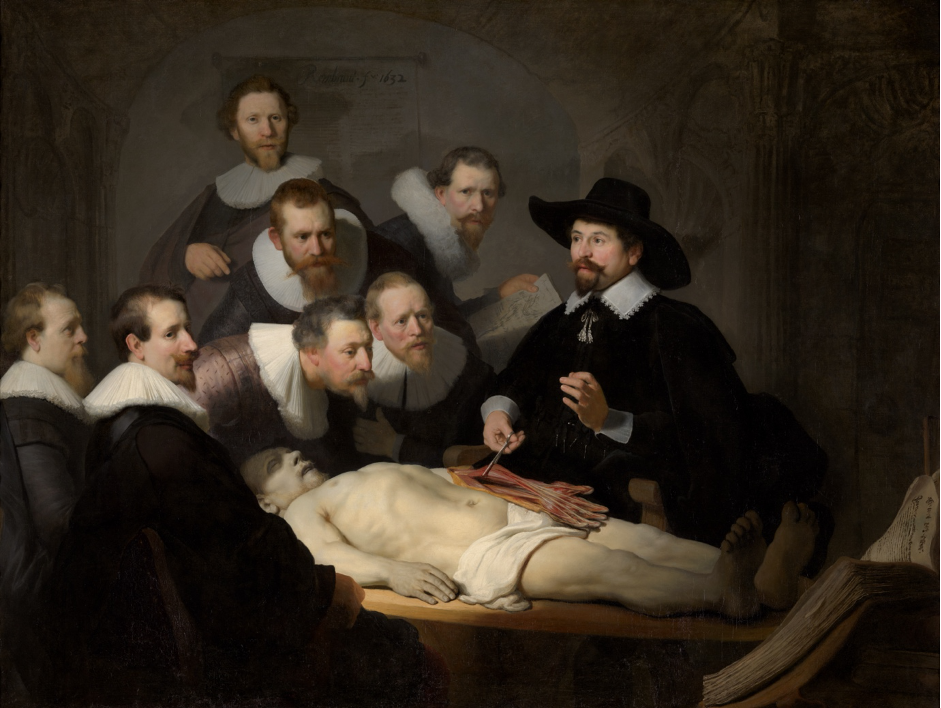
Q1. What do you see in this painting? What kind of painting is it?
A1. We see a group of eight formally dressed bearded middle-aged men arranged in a semicircle around a supine full length naked (apart from a loin cloth) cadaver. The main focus and light is on this scene as there is no other information given about the space except the dimly lit classical architecture. The cadaver appears to be a young muscular man in his twenties or thirties judging by his taut skin and muscles. His left arm has been dissected to reveal muscles and tendons. One of the muscles is held up by a forceps by the hatted figure on the right. He appears to be instructing the other men who are observing with varying degrees of attention. This can be ascertained from their gazes, the most intense being from those closer to the head of the cadaver. The men at the back, top and to the right however, appear to be looking at us while the man on the lower left seems to be looking at something either outside of the picture frame or at the large open book, in part shadow, at the bottom right of the painting.
This is a group portrait type of painting.
Q2. Judging from the clothes the individuals are wearing, what century and country is depicted?
A2. The severe dark clothes with the white stiff collar are similar to those seen in paintings in seventeenth century Holland.
Q3. Who is the most important man in the painting? Why do you think so?
A3. The bearded man on the right in black, as he is the only person wearing a wide brimmed hat and he appears to be teaching the other men by showing the muscle in a forceps with his right hand while speaking with a raised left hand.
Q4. Does the anatomy of the dissected forearm look correct to you? If not, say why.
A4. It is hard to say without being an expert anatomist. It seems alright.
Notes:
The accuracy of the muscles and tendons has been disputed for decades yet there is no general consensus as to whether the flexor or extensor muscles are represented and whether the muscles in Dr Tulp’s forceps come from the lateral rather than the medial epicondyle of the humerus (see The Journal of Hand Surgery, Vol. 31A, No. 6, July-August 2006; doi:10.1016/j.jhsa.2006.02.014).
All the people in the painting have been identified as a group of doctors from the Amsterdam Guild of Surgeons. Dr Tulp was a Praelector Anatomiae (Reader in Anatomy) to the Guild. The cadaver is that of a 28 year old executed criminal, Adriaan Adriaasz (a.k. a. Aris t’Kint). This is group portrait, for which each person paid a fee. Dr Tulp commissioned the painting and thus paid the largest amount. Although public dissections were performed once a year in 17th century Holland, this is a fictional recreation as usually the thorax and abdomen would be dissected before the limbs because of the increased perishability of the internal organs. In this painting only the forearm has been dissected while the rest of the body is intact.
Therefore, the main purpose of the staged painting is a group portrait with Dr Tulp as the main focus.
In 17th century Puritan Holland, there was also a moral interpretation to such paintings as a kind of ‘momento mori’, a reminder of the transience of life.
The identification of the book on the bottom right is not known but is thought to be possibly Vesalius’ Anatomy, De Humani Corporis Fabrica ( 1514-1564), the first modern book of anatomy.

